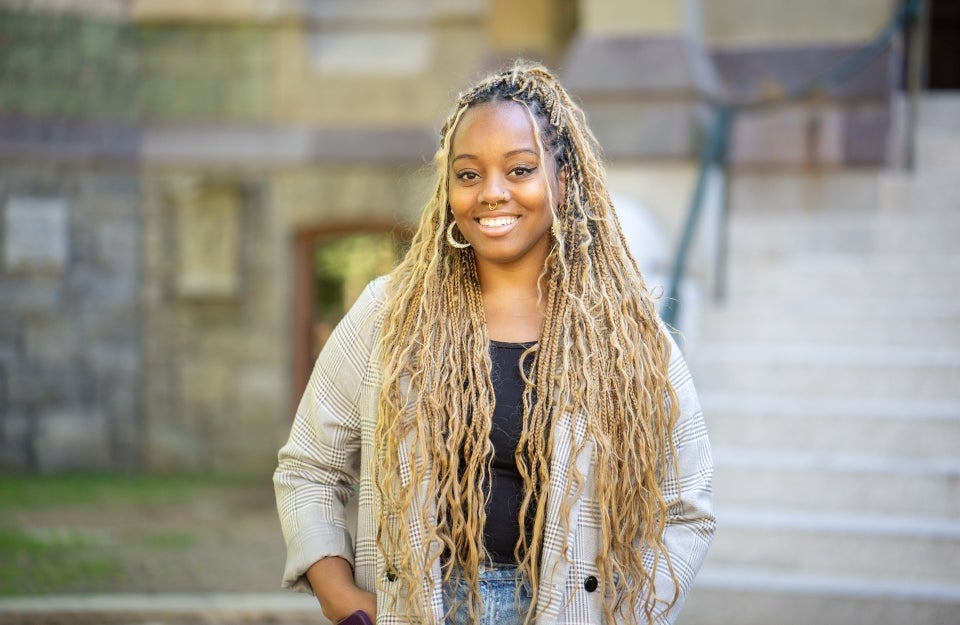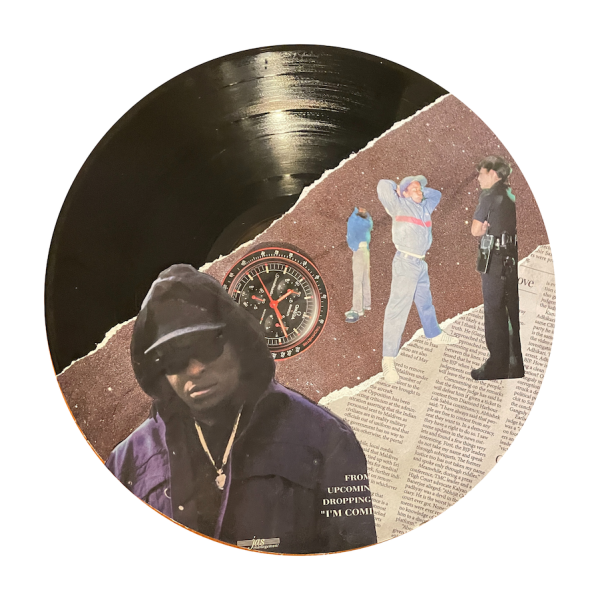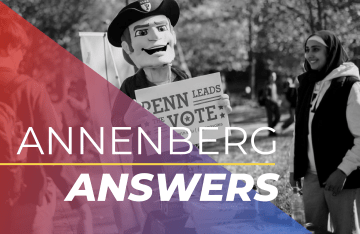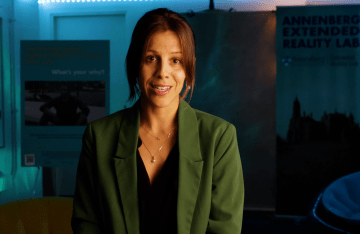Art and Academia — Making Meaning Beyond Words
Upcoming graduate Azsaneé Truss’s scholarship reaches people through image, sound, and story.

Azsaneé Truss calls herself a “thinking artist.” An upcoming Ph.D. graduate at the Annenberg School for Communication, she uses words, visuals, and sound to explore how Black cultural production challenges dominant ways of thinking and imagines new futures.
“My artistic practice is basically inseparable from my scholarship at this point,” she says. “At times, what I’m reading has inspired a piece of art, and sometimes I use my art practice to make sense of new academic concepts or ideas I have.”
Truss came to Annenberg with a multifaceted arts background — she grew up training to be a ballerina and playing the flute, inspired by her music teacher father. She attended a performing arts high school. Earning a Ph.D. in communication was never part of her original plan. But after receiving a bachelor’s degree in Business Information Systems, a stint working in tech, and getting a master’s in Instructional Technology and Media from Teachers College, Columbia University, Truss is now set to graduate from Annenberg this May.
Conspiracy Theories and Injustice
Truss’s dissertation, which she defended this spring, examines how conspiracy theories in Black American art are rooted in critical histories of racialized oppression.
“A lot of Black conspiracy theories are rooted in real things that have happened, often acts of racial injustice,” Truss says. “There's a different valence to conspiracy theorizing when there is a history of real atrocities against you.”
One conspiracy Truss explored in her dissertation is the theory that levees in New Orleans were bombed during Hurricane Katrina.
“This conspiracy theory is rooted in New Orleans’ history,” Truss says. “During the 1927 floods, the city of New Orleans blew up the levees in order to protect houses uptown, where the richer people lived, while neighborhoods downtown, where poor white, Black, and brown folks lived, were completely destroyed.”
Her dissertation is paired with an art exhibition in the Annenberg School Library — The Conspiracy Mixtapes, where Truss’s collages — colorful creations made of archival materials, from newspapers to album covers, sometimes displayed on vinyl records — dot the library’s walls. Visitors can also listen to a playlist using headphones in one of the library’s cubbies.

This piece is paired with chapter two of Truss’s dissertation — “Paranoid or Perceptive?: Theorizing the Crack Conspiracy in Hip-Hop Music.” In this chapter, Truss discusses the conspiracy theory that the CIA constructed the crack epidemic of the 1980s and 1990s.
Each artwork is accompanied by a short essay drawn from Truss’s dissertation, accessible to viewers via QR code.
From New York to Annenberg
Truss dipped her toes in the tech world in New York City after graduating from the University of Maryland, but realized it wasn’t for her. She wanted to pursue something that would allow her to use her tech background and marry it with her passion for education. She enrolled at Teachers College, Columbia University. There, she studied the ways in which media production can be used to teach youth critical media literacy skills.
While at Columbia, several of her professors encouraged her to pursue a Ph.D. One was Lalitha Vasudevan, a multimodal scholar who brought Truss to the Screening Scholarship Media Festival organized by Penn's Collective for Advancing Multimodal Research Arts group (CAMRA).
“Seeing all the multimodal scholarship on display pushed me to consider becoming a Ph.D. student,” she says. She applied, got in, and joined Penn at a very odd time — right after the world shut down at the start of the COVID-19 pandemic.
“My first year, we were totally remote the entire year. It was really, really strange, but I still connected with my cohort and professors,” Truss says.
Arts and Curation
During her first semester at Annenberg, Truss took a class with CAMRA Fellow Christina Knight — “Black Speculative Futures,” which she credits for inspiring her to pick up her art practice, which had been put on hold while working in tech.
“The final was multimodal — we put together pieces that spoke to the readings and the concepts that we were going over in the class,” Truss says. “After that project, I kept making things.”
Her main medium is collage, and looking back, she says that collaging helped her deal with the isolation of the pandemic. She had newly moved to Philadelphia, her classes were online, and art was a way of processing her thoughts.
During her five years at Annenberg, her collages have been shown in exhibits across the city, including at the Philadelphia Free Library, City Hall, and the Da Vinci Art Alliance. She has taught collage workshops at Penn, Boston College, and The Arts League of Philadelphia.
“Collage has become a vital part of how I think, feel, and create as a scholar. It teaches me to honor fragmentation, to work with what’s been discarded, and to find beauty and meaning in juxtaposition,” Truss says. “It's helped me to sort through my more nonlinear ideas and make them legible in new ways.”
Last fall, Truss was a co-curator of “Present Futures: Experiments in Feminist Futurity,” which opened in conjunction with the two-day Transnational Feminist Networks Symposium in September. The contemporary art exhibition at Annenberg envisioned feminist solidarities across space and time, in everyday life, with an outlook towards “the future we want to see, right now, in the present.”
“I think the exhibition spoke to the importance of multimodal scholarship, which offers people different — and sometimes more accessible — entry points into intellectual conversations,” she says. “One of the key concepts behind multimodality is the idea that we make meaning in a variety of ways, and for some people, a video or a painting or a collage might communicate in a way that speaks more directly to how they understand the world. Art and media are often able to present ideas and resonate with people in ways that written words or spoken language can’t.”
A Passion for Teaching
Truss is a consummate teacher and has won several awards for her teaching. In 2024, she won the Penn Prize for Excellence in Teaching by Graduate Students, a highly competitive award that recognizes the profound impact of graduate students on education at Penn. Nominations come directly from undergraduate and graduate students.
Truss was nominated for her work as a teaching fellow for Professor Guobin Yang's “Media Culture & Society in Contemporary China” course in Spring 2023 and for Dean Sarah Banet-Weiser's “Critical Approaches to Popular Culture” course in Fall 2023.
Communication major Kara Butler (C’26), who was in Truss’s recitation section for “Critical Approaches to Popular Culture,” praised her commitment to the class. “She was always so genuine and engaging in class,” Butler says. “I looked forward to going to recitation and getting to talk about the material because I never felt like I was being talked at.” Butler says it was encouraging to have an instructor who she could relate to: “She is a Black female artist, pursuing similar things.
Of Truss’s teaching, Professor Guobin Yang says: “I would count Azsaneé as one of the top teaching fellows I have had in my decade of teaching at Penn.”
“Teaching and mentoring undergrads has been one of the most meaningful parts of my graduate journey,” Truss says. “I love creating space for students to explore big ideas, ask hard questions, and find their voice. Their energy is contagious, and I learn so much from them. Watching my students grow into more critical thinkers and confident people has been such a privilege.”
What’s Next
Truss is still debating her future — whether that’s lecturing, traveling, or teaching art.
No matter what, she will continue her art practice and take lessons from Annenberg with her.
“At Annenberg, I’ve had the space to explore a number of ways to unsettle dominant ways of knowing and challenge how power operates through media and culture,” she says. “Multimodal scholarship has shown me how powerful research can be when it reaches people through image, sound, and story. It’s deepened my commitment to making knowledge that’s not only rigorous, but also resonant.”



